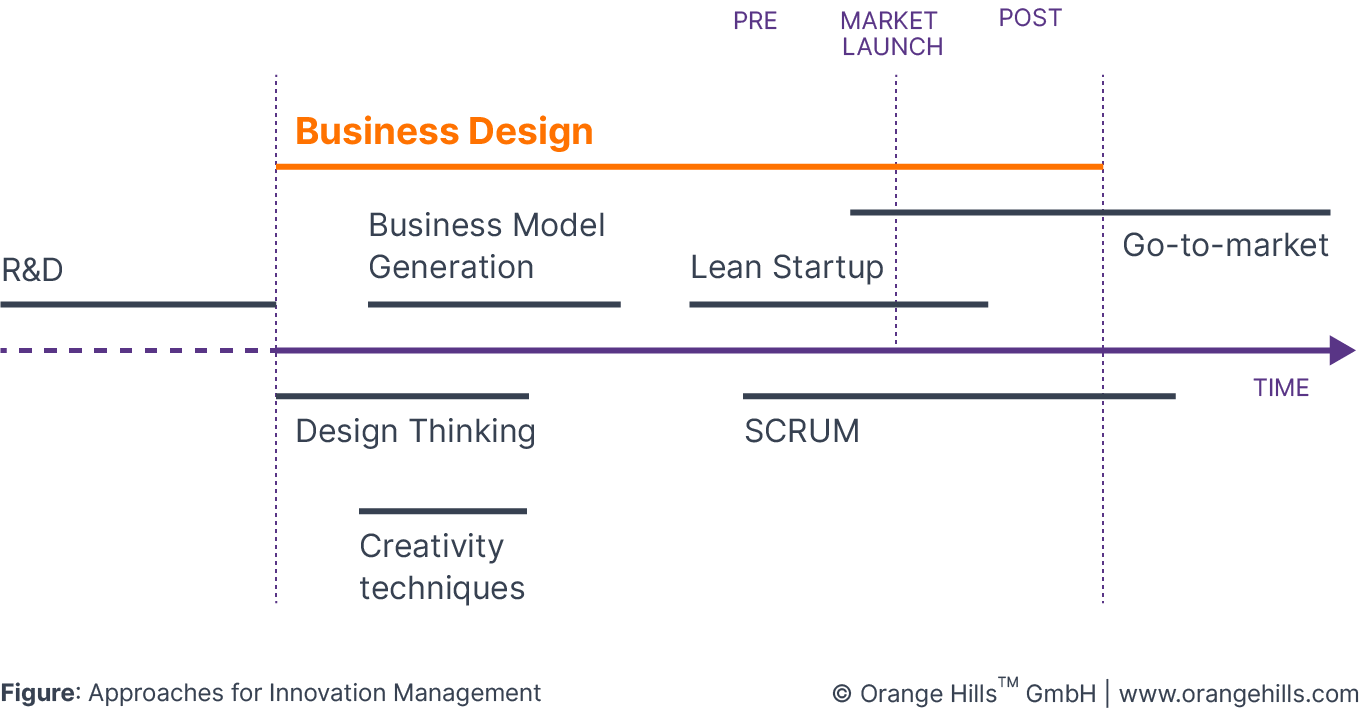Why Business Design ≠ ...
If you are new to Business Design you may ask yourself how the approach differs from others like R&D, Business Model Generation, Design Thinking, Lean Startup & SCRUM. We answer this question in this article.
Bernhard Doll
Business Design Maverick
Content
1. Introduction
Business Design is a unique combination of different approaches and methods such as R&D, Business Model Generation, Lean Startup, Design Thinking, Strategic Management, Organizational Psychology and Engineering. We haven't reinvented the wheel but created a consistent and powerful framework that truly covers the entire journey from ideas to market success.
2. ... ≠ R&D
R&D (= research & development) is very often focused on technical feasibility studies to figure out whether a technology or material can be used in products, software systems etc. The aim is to learn around technical questions. Answers to these questions may be a great trigger for Business Design projects, which means that typical R&D projects usually happen BEFORE Business Design projects to feed them with great insights around technology. You will find more information about this phase in our section around "Management System for Business Design".
The following illustration depicts when and how different approaches for innovation management are useful for creating innovation:

3. ... ≠ Business Model Generation
Thanks to the guys of "Business Model Generation", many of us have started thinking in business models, not only products, services, features etc. A great contribution to the world of management and strategy. Nevertheless, filling the original Business Model Canvas and Value Proposition Canvas is only 1% of the effort needed to turn ideas into practice. Successful innovation doesn't happen in workshop rooms, but literally out on the "street" where your customers are. Browse through this Knowledge Base and you will instantly see that Business Design gives you the other 99% needed to design, validate and implement new business.
4. ... ≠ Lean Startup
Well, Business Design is based on the same idea of "agile" development and learning processes as many other approaches out there for years, such as SCRUM (see below), Extreme Programming or Lean Startup. Lean Startup has, in fact, propelled "agile" thinking to the business level, which has actually opened up the market for Business Design. Business Design, however, goes beyond the basic ideas of Lean Startup by structuring every single step necessary to build new business. Especially when it comes to testing, prototyping, linking MVPs (= minimum viable products) to business models, Business Design is far ahead of Lean Startup.
5. ... ≠ Design Thinking
Design Thinking has championed a discipline called "Human Factors" and made a very valuable contribution in the way we can empathize with customers through qualitative research and observations. Also, the way ideas and knowledge are visualised in Design Thinking is something we learn from every day.
Design Thinking, however, neglects implicitly many important factors:
Design Thinking doesn't care that much about the context of innovation projects and how they are embedded into an organization. Design Thinking focuses primarily on customers and ideas. But reality has taught us that a great idea isn't worth that much. It has to be linked to strategy of a company, its organisation and culture as well as people and their interests and passion in order to succeed.
Design Thinking is very sloppy in the way uncertain aspects of new ideas are tested. It is something like "go out and talk to people and see what they say". Business Design is way more accurate in how experimental settings are designed that lead to valid insights and support decision-making. Business Design combines scientific precision with entrepreneurial pragmatism in a smart way.
Design Thinking often ignores business issues. They claim to have an interdisciplinary perspective ("Customer", "Technology", "Business"), but in fact, they often ignore questions around profitability, costs and investments needed to develop a great new business model, product, service or software.
Overall, Design Thinking is a great approach for human-centred ideation at early phases but not suitable for commercialisation and bringing new products, services, software or even business models to the market.
6. ... ≠ SCRUM
SCRUM is a lightweight framework for project management primarily for software engineering teams. SCRUM has been originally invented by Ken Schwaber and Jeff Sutherland. What is SCRUM? In simple words: A "SCRUM team", facilitated by a "SCRUM master", works for a "Product Owner" to build a piece of software in a series of short 1-2 weeks sprints. All features of the envisioned software are stored in a product backlog of user stories. Task management happens in "Daily SCRUMS" and a "Sprint backlog" with prioritised requirements. SCRUM is basically follows the principles of the "Manifesto for Agile Software Development":
Individuals and interactions over processes and tools
Working software over comprehensive documentation
Customer collaboration over contract negotiation
Responding to change over following a plan
That's it. Sounds simple? Execution is not, which is why there are not many companies that eventually lived up to the standards of SCRUM. Many people just use the fancy language to pretend to be "agile". However, we love SCRUM for what it is in the software engineering world.
But SCRUM is NOT suitable for building and validating innovative business models in complex organisations with interdisciplinary teams and constant contact with reality (incl. customers).
